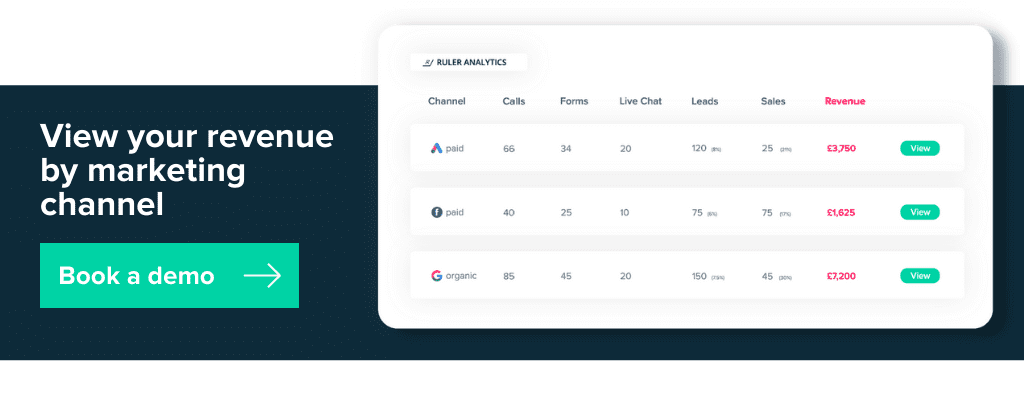Keep track of deals in your pipeline and measure the impact of your marketing on revenue.
“What’s the ROI on that?”
It’s a question that many executives ask, and they have every right to.
Your executives deserve to know that the money they’re investing into marketing is paying off.
And yet some marketers are failing to deliver reports that show how marketing has participated in generating revenue.
If you’re one of those marketers, it’s time to reevaluate your approach.
With CRM deal tracking, you can pinpoint where your highest-value deals originated and effectively prove marketing’s impact on revenue.
But what tools, technology, and data do you need to track CRM deals?
Keep reading, and we’ll explain everything you need to know.
In this guide, we’ll discuss:
Pro Tip
Ruler makes the process of CRM deal tracking easy. It tracks data on a visitor level, allowing you to successfully attribute CRM leads and revenue back to your landing pages across multiple campaigns, ads, keywords and more.
Track where your leads came from with Ruler
So we’re on the same page, let’s first discuss what a deal is and why they’re so important.
A deal is a lead or opportunity that has moved to the last stage of your sales pipeline.
Most sales pipelines start with a lead and end with a deal.
Marketing will convert anonymous visitors into potential prospects and send them to the CRM as leads.
This is where the sales team takes over. Sales will nurture leads through each stage of the pipeline until they’re either marked as won, lost or abandoned.
With a solid strategy to track your CRM deals, you’ll be able to:
If tracking CRM deals is so important, why aren’t more marketers doing it? It boils down to the following challenges.
Relying on the wrong tools is where most marketers go wrong.
Our data backs it up. 53% of marketers lack the right tools and integrations to track leads through different stages of the marketing and sales funnel.
As a provider of marketing analytics and attribution, we get people to come to us every day looking for help with their marketing performance tracking.
In almost every conversation we have with a lead or potential customer, the tool ‘Google Analytics’ comes up.
Honestly? This doesn’t come as a surprise. We found that 90% of marketers consider Google Analytics their go-to choice for marketing measurement.
But there’s one fundamental issue with Google Analytics as a standalone product. Google Analytics doesn’t track individual users.
Related: Google Analytics user tracking explained
It only tracks unique user IDs and prohibits sending personal information such as email or IP addresses.
You can see in Google Analytics that a campaign or marketing channel has converted “a lead”, but it has no record of who that is.
Without this information, it’s impossible to track where leads come from, how far they make it down the funnel and what they’re worth.
Sales and marketing misalignment is another huge problem.
Related: Guide to sales and marketing alignment
Some companies treat marketing and sales as two separate functions.
Marketing’s job is to bring in as many leads as possible, and the sales are responsible for converting them into revenue.
As these teams work in silos and focus on different stages of the funnel, data isn’t transferred between them.
And the process of CRM deal tracking becomes somewhat impossible.
Take the marketing team, for example.
Marketing’s job is to deliver leads to the sales team, right?
If sales aren’t sharing information on how leads are converting into deals, how is the marketing team meant to track the success of their campaigns?
They can’t.
CRM deal tracking can be overwhelming—we get it.
We speak to marketers every day, and they all find the process of deal tracking hard to understand.
But connecting your marketing efforts to CRM deals is one of the best things you can do for your company’s growth.
Once you invest in the right tools and understand how to use them, the process of CRM deal tracking becomes a lot easier.
We’re living proof of that.
For the next part of this article, we’re going to show you what tools, steps and actions we take to track leads across the entire pipeline to close. Here’s a quick overview of those steps:
The best place to start is by tracking your visitors individually.
Related: A complete guide to website visitor tracking
By measuring the movements of specific visitors, you can track what pages they’ve viewed and pinpoint what marketing channels they engaged with before converting into a lead or deal.
To track visitor data, we use our product Ruler Analytics.
We might sound biassed, but give us a chance to explain why Ruler is so important.
Ruler is a marketing attribution tool that uses first-party cookies to identify our website users and tracks their unique journeys over multiple traffic sources, ads, keywords and more.
Take the journey below, for example.
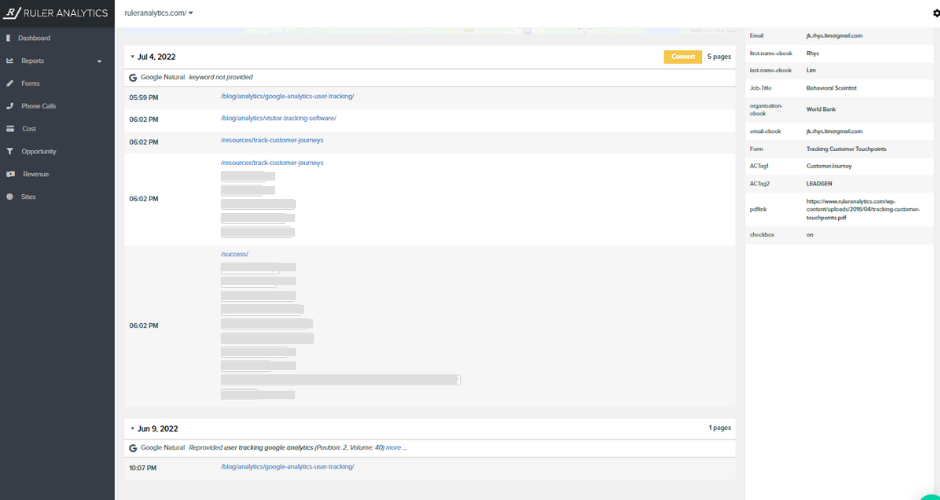
We can see that this specific user found our website by typing in the keyword “marketing attribution” in Google and converted into a lead by filling out a form.
This step is vital because, without Ruler, we wouldn’t be able to track the unique marketing touchpoints of our leads, and the process of measuring marketing’s impact on deals would be almost impossible.
Pro Tip
Tracking customer interactions across multiple channels unlocks powerful insights that you can use to improve your customer experience and marketing efforts. See how Ruler can help you follow the complete lifecycle from awareness to loyalty.
How Ruler tracks full customer journeys
Once a visitor converts into a lead, their conversion details and marketing touchpoints are sent to our CRM.
A lead could convert by phone call, form or live chat, but we can easily track these mediums using Ruler’s attribution and lead capturing software.
When a lead is created in the CRM, their record is enriched with Ruler’s attribution data.
The example below is the visitor we saw earlier in Ruler’s dashboard.
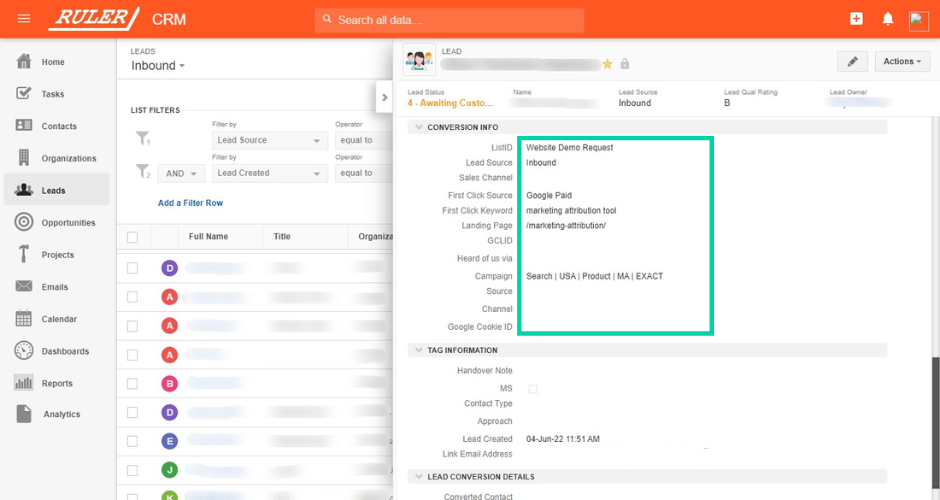
They’ve been qualified as a lead, and their conversion info has been updated with their specific marketing touchpoints.
Now that we have visibility of this lead, we can track their movements as they move down the pipeline.
We can see whether this lead converts into a deal or falls out of the pipeline.
As more leads convert into deals, we can determine which marketing efforts drive the most value and optimise our campaigns to attract more high-converting customers.
Manually tracking where each deal came from in the CRM and working out your marketing ROI can be a lot of work if you frequently convert leads into customers.
This is where Ruler comes in handy, again.
When a deal converts into a deal, Ruler uses a built-in integration and automatically passes the revenue data back to its dashboard.
Related: How Ruler attributes revenue to your marketing
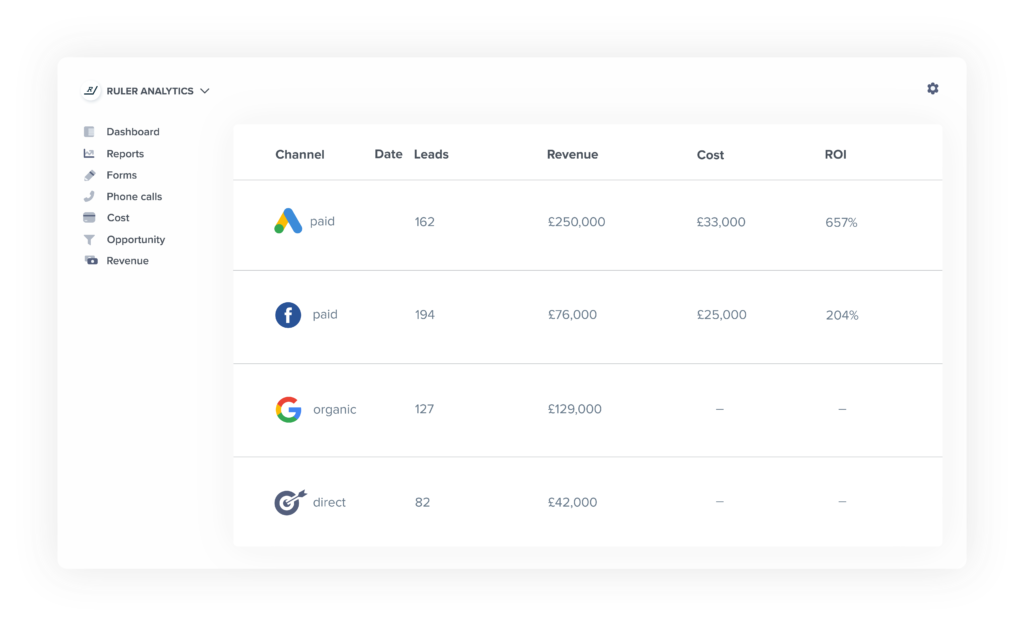
Ruler then attributes the deal amount across the customer’s unique marketing touchpoints, allowing us to see how much revenue was generated from each marketing source, keyword and campaign.
With Ruler’s revenue attribution reporting, we can determine which channels convert deals best and easily track our revenue metrics like ROI and ROAS.
Converting leads into deals is all well and good.
But if these deals don’t stick around, all the time, money, and effort you invest in generating leads will go to waste.
To ensure that our marketing is positively impacting retention, we send the data we’ve captured in Ruler to our subscription analytics platform ChartMogul.
Related: How we ChartMogul to close the loop between marketing and revenue
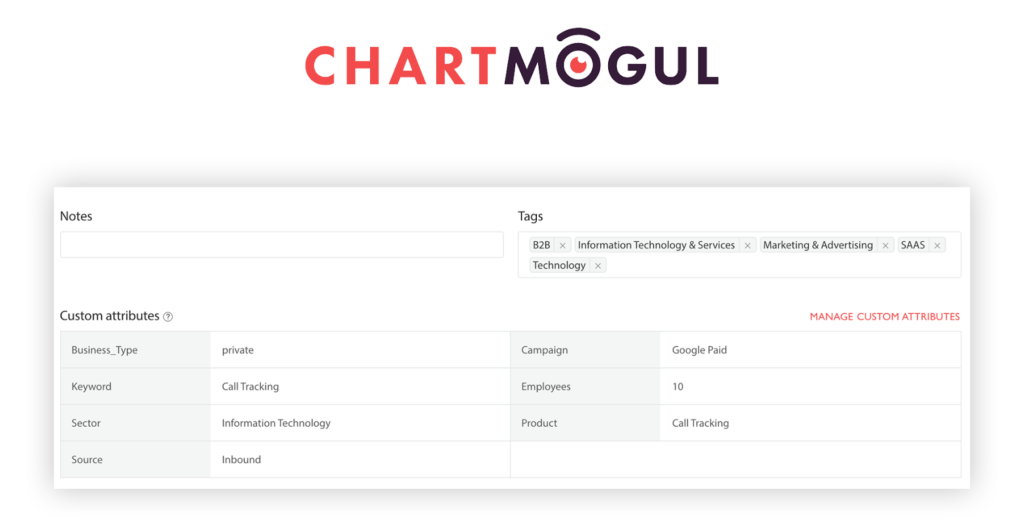
This allows us to track the lifetime value of our marketing efforts.
If we see a spike in churn, we can head over to ChartMogul and look out for any trends that may be a result of marketing.
For example, we may see a specific keyword associated with low-value customers.
To increase your lifetime value, we could reduce the spending around this keyword and reinvest it into other areas of marketing that have proven to drive more loyal customers.
Tracking how marketing impacts down-funnel activity is important to growing your company.
Connecting your marketing efforts to closed/won deals gives you the upper hand you need when it comes to making data-driven decisions to improve results.
When you know which marketing sources are generating the most profitable deals, you can optimise your efforts to drive additional revenue faster.
And that’s all that everyone wants, right?
Don’t forget, Ruler and its advanced attribution reporting options can help track your leads across the marketing and sales pipeline.
Discover everything you need to know about Ruler or book a demo to see how it can improve the quality of your sales and marketing reports.
